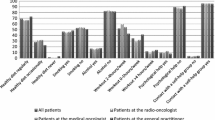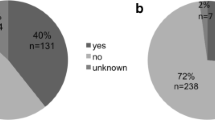Abstract
Purpose
Information on complementary and alternative medicine (CAM) use in Australian radiotherapy patients is sparse. This study investigated the type and prevalence of CAM amongst an Australian regional radiotherapy patient cohort and the disclosure of information to the consultant radiation oncologist.
Methods
A single hardcopy questionnaire survey was provided to patients regarding the use of CAM and discussion with the treating medical practitioner. The National Centre for Complementary and Alternative Medicine (NCCAM) classification was used to group responses. The study was open for a period of 4 months, and all patients on treatment during this period were approached.
Results
A total of 170 questionnaires were distributed to eligible patients, and 152 patients returned a completed questionnaire (89.4 % response rate). Sixty-nine of the 152 patients (45.4 %) reported active CAM use. Of the 69 patients who used CAM, mind–body medicine (n = 54, 78.3 %) and biological-based therapies (n = 54, 78.3 %) were the commonest NCCAM group, whilst manipulative/body-based therapies (n = 44, 63.8 %), whole medical systems (n = 7, 10.1 %) and energy therapies (n = 5, 7.2 %) were the least common. The most common therapies were vitamins and mineral supplementation (n = 33, 47.8 %) and massage therapy (n = 18, 26.1 %). Of note, only 29 participants stated that they had discussed CAM therapies with their radiation oncologist.
Conclusions
CAM use was prevalent amongst cancer patients undergoing radiotherapy, but frequently not discussed with the treating radiation oncologist. Considering the high prevalence of CAM, further resources could be justifiably directed at providing this service for cancer patients to foster a more holistic approach to their care.
Similar content being viewed by others
References
National Institute of Health, National Centre for Complementary and Alternative Medicine. What is Complementary and Alternative Medicine. Available from:-http://nccam.nih.gov/health/whatiscam; Accessed 26th October 2013
Wieland LS, Manheimer E, Berman BM (2011) Development and classification of an operational definition of complementary and alternative medicine for the Cochrane collaboration. Altern Ther Health Med 17(2):50–59
Xue CC, Zhang AL, Lin V, Da Costa C, Story DF (2007) Complementary and alternative medicine use in Australia: a national population-based survey. J Altern Complement Med 13(6):643–650. doi:10.1089/acm.2006.6355
Shorofi SA, Arbon P (2010) Complementary and alternative medicine (CAM) among hospitalised patients: an Australian study. Complement Ther Clin Pract 16(2):86–91. doi:10.1016/j.ctcp.2009.09.009
Richardson MA, Sanders T, Palmer JL, Greisinger A, Singletary SE (2000) Complementary/alternative medicine use in a comprehensive cancer center and the implications for oncology. J Clin Oncol Off J Am Soc Clin Oncol 18(13):2505–2514
Pud D, Kaner E, Morag A, Ben-Ami S, Yaffe A (2005) Use of complementary and alternative medicine among cancer patients in Israel. Eur J Oncol Nurs 9(2):124–130. doi:10.1016/j.ejon.2005.03.011
Hyodo I, Amano N, Eguchi K, Narabayashi M, Imanishi J, Hirai M, Nakano T, Takashima S (2005) Nationwide survey on complementary and alternative medicine in cancer patients in Japan. J Clin Oncol Off J Am Soc Clin Oncol 23(12):2645–2654. doi:10.1200/JCO.2005.04.126
Scott JA, Kearney N, Hummerston S, Molassiotis A (2005) Use of complementary and alternative medicine in patients with cancer: a UK survey. Eur J Oncol Nurs 9(2):131–137. doi:10.1016/j.ejon.2005.03.012
Afifi FU, Wazaify M, Jabr M, Treish E (2010) The use of herbal preparations as complementary and alternative medicine (CAM) in a sample of patients with cancer in Jordan. Complement Ther Clin Pract 16(4):208–212. doi:10.1016/j.ctcp.2010.05.001
Lifshitz DA, Shikanov SA, Razmaria AA, Eggener SE, Liao C, Chang A, Shalhav AL (2011) Clinical and histologic predictors of renal function decline after laparoscopic partial nephrectomy. J Endourol Endourological Soc 25(9):1435–1441. doi:10.1089/end.2010.0646
Klafke N, Eliott JA, Wittert GA, Olver IN (2012) Prevalence and predictors of complementary and alternative medicine (CAM) use by men in Australian cancer outpatient services. Ann Oncol 23(6):1571–1578. doi:10.1093/annonc/mdr521
Field KM, Jenkins MA, Friedlander ML, McKinley JM, Price MA, Weideman P, Keogh LA, McLachlan SA, Lindeman GJ, Hopper JL, Butow PN, Phillips KA (2009) Predictors of the use of complementary and alternative medicine (CAM) by women at high risk for breast cancer. Eur J Cancer 45(4):551–560. doi:10.1016/j.ejca.2008.09.023
Pedersen CG, Christensen S, Jensen AB, Zachariae R (2009) Prevalence, socio-demographic and clinical predictors of post-diagnostic utilisation of different types of complementary and alternative medicine (CAM) in a nationwide cohort of Danish women treated for primary breast cancer. Eur J Cancer 45(18):3172–3181. doi:10.1016/j.ejca.2009.09.005
Kao GD, Devine P (2000) Use of complementary health practices by prostate carcinoma patients undergoing radiation therapy. Cancer 88(3):615–619. doi:10.1002/(SICI)1097-0142(20000201)88:3<615::AID-CNCR18>3.0.CO;2-P
Swarup AB, Barrett W, Jazieh AR (2006) The use of complementary and alternative medicine by cancer patients undergoing radiation therapy. Am J Clin Oncol 29(5):468–473. doi:10.1097/01.coc.0000221326.64636.b2
Micke O, Bruns F, Glatzel M, Schönekaes K, Micke P, Mücke R, Büntzel J (2009) Predictive factors for the use of complementary and alternative medicine (CAM) in radiation oncology. Eur J Integr Med 1(1):19–25
Wong LC, Chan E, Tay S, Lee KM, Back M (2010) Complementary and alternative medicine practices among Asian radiotherapy patients. Asia Pac J Clin Oncol 6(4):357–363
Wong J, Bolderston A (2007) A descriptive study of departmental policies regarding patients use of complementary and alternative medicine in Ontario radiation therapy centres. Can J Med Radiat Technol 38(1):32–38
Bolderston A, Mitchell F, Cowan B, Mawson C (2008) Radiation therapists’ experiences with complementary alternative medicine use by their patients: a preliminary study. J Med Imaging Rad Sci 39:128–134
Baum M, Ernst E, Lejeune S, Horneber M (2006) Role of complementary and alternative medicine in the care of patients with breast cancer: report of the European Society of Mastology (EUSOMA) Workshop, Florence, Italy, December 2004. Eur J Cancer 42(12):1702–1710. doi:10.1016/j.ejca.2006.02.020
Pirri C (2011) Integrating complementary and conventional medicine. Cancer Forum 35(1):1–9
Rausch SM, Winegardner F, Kruk KM, Phatak V, Wahner-Roedler DL, Bauer B, Vincent A (2011) Complementary and alternative medicine: use and disclosure in radiation oncology community practice. Support Care Cancer 19(4):521–529
Chen LN, Suy S, Uhm S, Oermann EK, Ju AW, Chen V, Hanscom HN, Laing S, Kim JS, Lei S, Batipps GP, Kowalczyk K, Bandi G, Pahira J, McGeagh KG, Collins BT, Krishnan P, Dawson NA, Taylor KL, Dritschilo A, Lynch JH, and Collins SP (2013) Stereotactic body radiation therapy (SBRT) for clinically localized prostate cancer: the Georgetown University experience. Radiat Oncol. 8: p. 58. DOI: 10.1186/1748-717X-8-58
Robotin MC, Penman AG (2006) Integrating complementary therapies into mainstream cancer care: which way forward? Med J Aust 185(7):377–379
Hollenberg D, Cowan B, Wright N (2008) New and uncharted territory: integrative medicine in the medical radiation sciences. Can J Med Rad Technol 38(4):23–30
Thomas J, Beinhorn C, Norton D, Richardson M, Sumler SS, Frenkel M (2010) Managing radiation therapy side effects with complementary medicine. J Soc Integr Oncol 8(2):65–80
Aksu MG, Bozcuk HS, Korcum AF (2008) Effect of complementary and alternative medicine during radiotherapy on radiation toxicity. Support Care Cancer 16(4):415–419. doi:10.1007/s00520-007-0390-0
Acknowledgments
The authors wish to acknowledge the input and assistance of Judy Andrews, Catherine Anderson and Kathleen Murphy. In addition, the authors would like to thank the patients who participated in this study.
Conflict of interest statement
There is no conflict of interest to note.
Disclosures
None
Author information
Authors and Affiliations
Corresponding author
Rights and permissions
About this article
Cite this article
Hunter, D., Oates, R., Gawthrop, J. et al. Complementary and alternative medicine use and disclosure amongst Australian radiotherapy patients. Support Care Cancer 22, 1571–1578 (2014). https://doi.org/10.1007/s00520-014-2120-8
Received:
Accepted:
Published:
Issue Date:
DOI: https://doi.org/10.1007/s00520-014-2120-8




